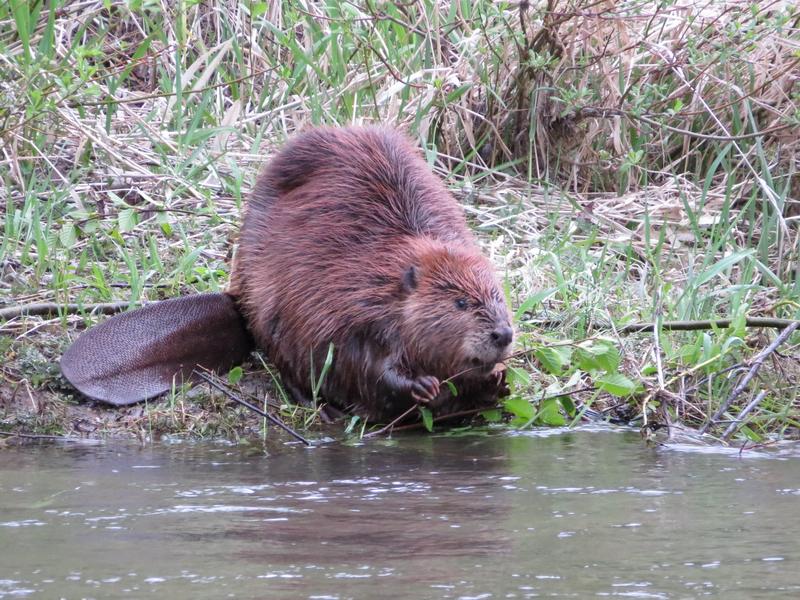Beavers are widely distributed across the U.S. and are known for their dam-building behavior. These dams provide them protection from predators, but the impacts of their dam building can occasionally bring them into conflict with humans.
Description and Range
Physical description
Beavers are the largest living rodents in North America, with adults averaging 40 pounds in weight and measuring more than 3 feet in length, including the tail. These semi-aquatic mammals have webbed hind feet, large incisor teeth, and a broad, flat tail. The tail of a large beaver may be 15 inches long and 6 inches wide. It is covered with leathery scales and sparse, coarse hairs.
The beaver’s tail has important uses both in the water and on land. In the water, the animal uses its flexible tail as a four-way rudder. When diving after being frightened, a beaver loudly slaps the water with its tail; the sound warns all beavers in the vicinity that danger is near, and perhaps serves to frighten potential predators.
On land, the tail acts as a prop when a beaver is sitting or standing upright. It also serves as a counterbalance and support when a beaver is walking on its hind legs while carrying building materials with its teeth, front legs, and paws. Contrary to common belief, beavers do not use their tails to plaster mud on their dams.
The tail stores fat, and because it is nearly hairless, releases body heat, helping the beaver to regulate its body temperature.
Geographic range
Once among the most widely distributed mammals in North America, beavers were eliminated from much of their range in the late 1800s because of unregulated trapping. With a decline in the demand for beaver pelts, and with proper management, they became reestablished in much of their former range and are now common in many areas.
Regulations
Licenses and permits
Because beavers’ legal status, trapping restrictions, and other information change, contact your local wildlife office for updates.
The beaver is classified as a furbearer (WAC 220-400-020). A trapping license and open season are required to trap and harvest a beaver. Visit the Furbearer trapping seasons and rules page for more information.
It is unlawful to release a beaver anywhere within the state, other than on the property where it was legally trapped, without a permit to do so (RCW 77.15.250; WAC 220-450-010). Click here for permitted beaver relocator information.
The owner, the owner’s immediate family, an employee, or a tenant of property may trap or kill a beaver on that property if the beaver is threatening human safety or causing property damage (RCW 77.36.030). In such cases, no special trapping permit is necessary for the use of live traps. However, a special trapping permit is required for the use of all traps other than live traps (RCW 77.15.192, 77.15.194; WAC 220-417-040). There are no exceptions for emergencies and no provisions for verbal approval. All special trapping permit applications must be in writing on a form available from WDFW.
To remove or modify a beaver dam you must have a Hydraulic Project Approval (HPA)—a permit issued by WDFW for work that will use, obstruct, change, or divert the bed or flow of state waters (RCW 77.55). A permit application can be obtained from your WDFW Regional Office or from the Hydraulic Project Approval (HPA) web page.
In emergency situations (when an immediate threat to property or life exists), verbal approval from WDFW can be obtained for work necessary to solve the problem. A 24-hour hotline 360-902-2537 is available for emergency calls during nonworking hours. During normal hours, contact your nearest WDFW Regional Office.
Living with wildlife
Beavers are found where their preferred foods are in good supply—along rivers, and in small streams, lakes, marshes, and even roadside ditches containing adequate year-round water flow. In areas where deep, calm water is not available, beavers that have enough building material available will create ponds by building dams across creeks or other watercourses and impounding water.
Beavers dams create habitat for many other animals and plants of Washington. In winter, deer and elk frequent beaver ponds to forage on shrubby plants that grow where beavers cut down trees for food or use to make their dams and lodges. Weasels, raccoons, and herons hunt frogs and other prey along the marshy edges of beaver ponds. Migratory waterbirds use beaver ponds as nesting areas and resting stops during migration. Ducks and geese often nest on top of beaver lodges since they offer warmth and protection, especially when lodges are formed in the middle of a pond. The trees that die as a result of rising water levels attract insects, which in turn feed woodpeckers, whose holes later provide homes for other wildlife.
The beaver’s incisors (front teeth) are harder on the front surface than on the back, and so the back wears faster. This creates a sharp edge that enables a beaver to easily cut through wood.
Like many rodents, beavers construct nesting dens for shelter and for protection against predators. These may be burrows in a riverbank or the more familiar lodges built in the water or on the shore. However, the basic interior design varies little and consists of one or more underwater entrances, a feeding area, a dry nest den, and a source of fresh air.
Food and feeding habitats
- Beavers eat the leaves, inner bark, and twigs of aspen (a favorite food), alder, birch, cottonwood, willow, and other deciduous trees. Beavers also eat shrubs, ferns, aquatic plants, grasses, and crops, including corn and beans.
- Coniferous trees, such as fir and pine, are eaten occasionally; more often, beavers will girdle and kill these trees to encourage the growth of preferred food plants, or use them as dam building material.
- Beavers have large, sharp, upper and lower incisors, which are used to cut trees and peel bark while eating. The incisors grow their entire lives, but are worn down by grinding them together, tree cutting, and feeding.
- Fermentation by special intestinal microorganisms allows beavers to digest 30 percent of the cellulose they ingest.
- When the surface of the water is frozen, beavers eat bark and stems from a food “cache” (a safe storage place) they have anchored to the bottom of the waterway for winter use. They also swim out under the ice and retrieve the thick roots and stems of aquatic plants, such as pond lilies and cattails.
- Food caches are not found consistently where winters are comparatively mild, such as in the lowlands of western Washington.

Beaver dams
- Beavers flood areas for protection from predators, for access to their food supply, and to provide underwater entrances to their den. Flooded areas also wet the soil and promote the growth of favored foods.
- Beavers living on water bodies that maintain a constant level (e.g., lakes, large rivers) do not build dams.
- Dams are constructed and maintained with whatever materials are available—wood, stones, mud, and plant parts. They vary in size from a small accumulation of woody material to structures 10 feet high and over 165 feet wide.
- The feel and sound of flowing water stimulate beavers to build dams; however, they routinely let a leak in a dam flow freely, especially during times of high waters.
- Beavers keep their dams in good repair and will constantly enlarge the dams as the water level increases in their pond. A family of beavers may build and maintain one or several dams in their territory.
- In cold areas, dam maintenance is critical. Dams must be able to hold enough water so the pond won’t freeze to the bottom, which would eliminate access to the winter food supply.
Lodges and bank dens
- Depending on the type of water body they occupy, beavers construct freestanding lodges or bank dens.
- Lodges and bank dens are used for safety, and a place to rest, stay warm, give birth, and raise young.
- Freestanding lodges are built in areas where the bank or water levels aren’t sufficient for a safe bank den.
- Lodges consist of a mound of branches and logs, plastered with mud. One or more underwater openings lead to tunnels that meet at the center of the mound, where a single chamber is created.
- Bank dens are dug into the banks of streams and large ponds, and beavers may or may not build a lodge over them. Bank dens may also be located under stumps, logs, or docks.
- One family can have several lodges or bank dens, but will typically use only one den during winter.
Reproduction and family structure
- A mated pair of beaver will live together for many years, sometimes for life.
- Beavers breed between January and March, and litters of one to eight kits (average four) are produced between April and June. The number of kits is related to the amount of food available (more food, more kits), and the female’s age.
- The female nurses the kits until they are weaned at 10 to 12 weeks of age.
- Most kits remain with the adults until they are almost two years old. (Some leave at 11 months and a few females may stay until they are three years of age.) The kits then go off on their own in search of mates and suitable spots to begin colonies, which may be several miles away.
- Beavers live in colonies that may contain 2 to 12 individuals. The colony is usually made up of the adult breeding pair, the kits of the year, and kits of the previous year or years.
- Populations are limited by habitat availability, and the density will not exceed one colony per ½ mile under the best of conditions.
Mortality and longevity
- Because of their size, behavior, and habitat, beaver have few enemies.
- When foraging on shore or migrating overland, beavers are killed by bears, coyotes, bobcats, cougars, wolves, and dogs.
- Other identified causes of death are severe winter weather, winter starvation, disease, water fluctuations and floods, and falling trees.
- Humans remain the major predator of beavers. Historically, beavers have been one of the most commonly trapped furbearers. In Washington, from 1991 to 2000, an annual average of 5,289 beavers were trapped. However, the average for the past three years has dropped to just over 1,000, due to RCW 77.15.194.
- Beavers live up to 12 years in the wild.
Viewing beavers
Beavers are nocturnal, but are occasionally active during the day. They do not hibernate, but are less active during winter, spending most of their time in the lodge or den.
Probably no animal leaves more obvious signs of its presence than the beaver. Freshly cut trees and shrubs, and prominent dams and lodges are sure indicators of their activity.
Look for signs of beavers during the day; look for the animals themselves before sunset or sunrise. Approach a beaver site slowly and downwind. (Beavers have poor eyesight but excellent hearing and sense of smell.) Look for a V-shaped series of ripples on the surface of calm water. A closer view with binoculars may reveal the nostrils, eyes, and ears of a beaver swimming.
If you startle a beaver and it goes underwater, wait quietly in a secluded spot and chances are that it will reemerge within one or two minutes. However, beavers are able to remain underwater for at least 15 minutes by slowing their heart rate.
When seen in the water, beavers are often mistaken for muskrats. Try to get a look at the tail: Beavers have a broad, flat tail that doesn’t show behind them when swimming, whereas muskrats have a thin tail that is either held out of the water or sways back and forth on the water’s surface as the animal swims.
Beavers stand their ground and should not be closely approached when cornered on land. They face the aggressor, rear up on their hind legs, and hiss or growl loudly before lunging forward to deliver extremely damaging bites.
Harvest sites
Beavers cut down trees, shrubs, and other available vegetation for food and building materials. Large stumps are pointed, 1 to 2 1/2 feet high, and sometimes the tree trunk is still attached.
Tooth marks look like twin grooves, each groove measuring 1/8 inch or more. There will be a pile of wood chips on the ground around the base of recently felled trees. Limbs that are too large to be hauled off are typically stripped of bark over the course of several days. The cut on small wood usually involves a 45-degree cut typical of rodents, but at a larger scale. Branches and twigs under ¾ inch in diameter are generally eaten entirely.
Most harvesting is done within 165 feet of the water’s edge. In areas with few predators, but a lean food supply, toppled trees and other signs of feeding may be found twice that distance from the den site. Beavers transport woody material even farther through upstream and downstream sites.
By late fall (earlier in cold winter areas of Washington), all family members concentrate on repairing and building up dams and the family lodge in preparation for winter. Harvesting is at its most intense level at this time of year.
Slides
Slides are the paths beavers make where they enter and leave the water. They are 15 to 20 inches wide, at right angles to the shoreline, and have a slicked down or muddy appearance.
Channels
Beavers construct channels or canal systems leading to their ponds, using them to float food—such as small, trimmed trees—from cutting sites. Canals are also safe travel ways for swimming instead of walking. With receding water levels during summer, beaver activity shifts toward building and maintaining channels to access new food supplies. Channels often look man-made, have soft, muddy bottoms, and are filled with 15 to 25 inches of water.
Food storage sites
Beavers that live in cold climates store branches of food trees and shrubs for winter use by shoving them into the mud at the bottom of ponds or streams near the entrance to their bank den or lodge.
Droppings
Beaver droppings are seldom found on land; those that are will commonly be found in the early morning at the water’s edge. Individual beaver droppings are usually cylindrical, up to 2½ inches long (sometimes shorter), and look as if they were formed of compressed sawdust. The diameter is an indication of the animal’s size, with 1 inch being average for adults. The color of fresh deposits is dark brown, with lighter-colored bits of undigested wood, all turning pale with age.
Sounds
In order to warn each other of danger, beavers slap their tails against the water, creating a loud splash. Sounds also include whining (noises made by kits), a breathy greeting noise, and loud blowing when upset.
Preventing conflict
Despite an appreciation for beavers and our best intentions to live with them, beavers can become a problem if their eating habits, and dam or den building activity, flood or damage property.
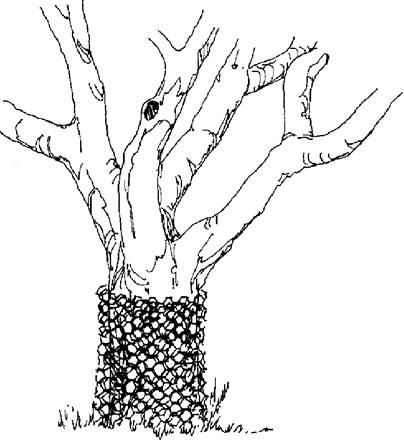
Before beginning any beaver control action, assess the beaver problem fairly and objectively. Are beaver really causing damage or creating hardship requiring control action? The very presence of beavers is often seen as a problem when, in fact, the beavers are causing no harm. You should also determine the type of damage or problem the animals are causing, and then match the most appropriate and cost-effective controls to the situation.
Once you have decided to control beaver damage, you have three control options: prevention, beaver translocation, or lethal control.
To prevent conflicts or remedy existing problems:
Choose and place plants carefully.
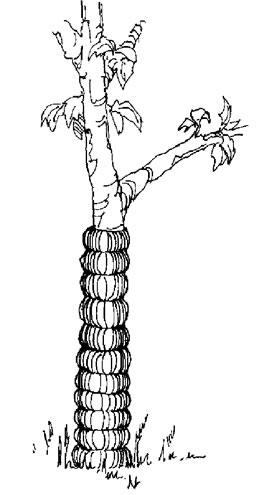
Plant areas with Sitka spruce, elderberry, cascara, osoberry (Indian plum), ninebark, and twinberry, because they are not the beavers’ preferred food plants. Densely plant aspen, cottonwood, willow, spirea (hardhack), and red-twig dogwood because, once their roots are well established the upper parts of the plants often resprout after being eaten. Planting preferred plants away from known beaver trails will limit losses.
Note: Beavers do use plants as construction materials that they might not eat.
Install barriers.
The trunks of individual large trees can be loosely wrapped with 3 foot high, galvanized welded wire fencing, hardware cloth, or multiple layers of chicken wire. Barriers can be painted to make them less noticeable. Welded wire fencing coated with green vinyl that helps the fencing blend in is also available.
Lengths of corrugated plastic drainpipe can be attached around the trunks of narrow-diameter trees.
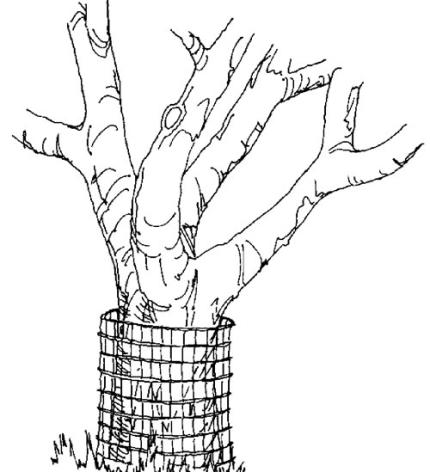
Note: Dark-colored pipe can burn trunks in full sun; wider diameter pipe or pipe with holes in it may prevent overheating problems.
Painting tree trunks with a sand and paint mix (2/3 cup masonry grade sand per quart of latex paint) has proven somewhat effective at protecting trees from beaver damage. The animals presumably don’t like the gritty texture.
Note: Preventing access to food sources may force beavers to eat other nearby plants, including roses and other ornamentals.
Surround groups of trees and shrubs with 3-foot high barriers made of galvanized, welded wire fencing or other sturdy material. (A beaver’s weight will pull down chicken wire and similar lightweight material.) Stake the barriers to prevent beavers from pushing them to the side or entering from underneath. An electric fence with two hot wires suspended 8 and 12 inches off the ground is also effective at protecting groups of plants.
Protect large areas that border beaver habitat by installing 4-foot high field fencing. Keep the bottom of the fence flush to the ground, or include an 18-inch wide skirt on the beaver side of the fence, to prevent beavers from entering underneath.
Groups of plants can be protected from beaver damage by surrounding them with wire fencing.
Apply repellents.
Commercial taste and odor repellents have provided mixed results, perhaps because they need to be reapplied often, particularly in moist weather. Taste and odor repellents are most effective when applied at the first sign of damage, when other food is available, and during the dry season.
Control the height of water behind a beaver dam to prevent flooding.
It may be possible to make a small change in the depth of a beaver pond by notching the beaver dam. Commonly this is completed by removing a one to three foot wide section (notch) out of the beaver dam at the intended depth using hand tools. This keeps the rise in the water level at a minimum by using one or more plastic pipes to continually drain the pond area (see “Flexible Leveler” below. Click to enlarge). For leveling systems to work properly, you will have to have at least 3 feet of water in the pond area for the beaver to stay.
The flow device can be constructed from plastic pipe measuring 4 to 12 inches in diameter, depending on the volume of water in the stream. The end extending upstream from the dam must be baffled to prevent beavers from damming or blocking the pipe.
Prevent beavers from plugging culverts.
To a beaver, a culvert probably looks like a hole in an otherwise fine dam. When they plug the hole, a flooded road can result. However, V-shaped, semicircular, or trapezoidal fences of woven wire mesh can prevent culverts from being plugged. Large flow-control devices that include a solid framework can be covered and used as a deck or wildlife viewing spot.
Note: Installation of flow control devices is complicated and generally requires a permit (see “Legal Status” for information on the Hydraulic Project Approval Permit (HPA) and your local WDFW habitat biologist contact information).
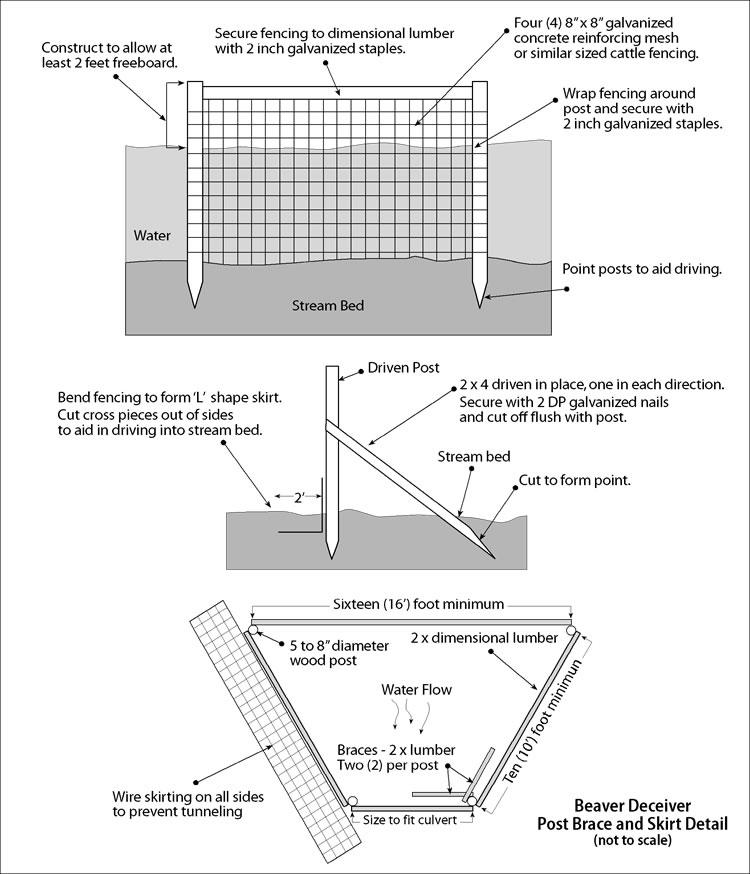
Dam removal.
It is pointless to destroy a beaver dam because beavers (frequently many at one time) often begin rebuilding them immediately after they are removed. Furthermore, it may be illegal to remove a beaver dam without a permit.
Live trapping and moving beavers
Live trapping and moving beavers elsewhere (translocating or relocating) is risky. Beavers may not survive relocation and those that do may move large distances from the release site. However, when tolerance or mitigation are not an option, landowners may consider relocation as an alternative to lethal removal. Please note that pursuant to WAC 220-450-030, it is unlawful to take live wildlife, wild birds, or game fish from the wild without a permit issued by the director except as otherwise provided by department rule.
Beaver relocation may be an option pursuant to RCW 77.32.585. With a permit, beavers may be relocated where beaver damage mitigation efforts have failed or are infeasible, where beavers are posing a public health and safety risk, or other irresolvable factors exist. Permitted beaver relocators may move beavers to a site that is unoccupied by other beavers as long as there is cooperation among adjacent landowners and local wildlife officials. A cooperative evaluation of existing habitat quality and potential adverse beaver activity is required. There is no guarantee that beavers will stay where released. They may find attractive habitat and forage on nearby properties. Relocation of entire family units to new habitat is strongly advised over relocation of individuals in order to encourage the beavers to settle near the release site.
To help ensure the survival of beavers, the watercourse at the release site should have a low gradient and the site should have adequate food supply. Beavers should be moved during their principal dam-building period, August to October. This will allow them time to gather a food cache, but limit their time to explore before having to settle in for the coming of winter. It may be helpful to provide beavers with a pickup-truck load of aspen or other trees to use as forage and building material at the release site. This may encourage the beavers to stay nearby.
Click here for more information about beaver relocation or to find a permitted beaver relocator.
Lethal control
Lethal control may become necessary when all efforts to dissuade problem beavers fail. Removing beavers is rarely a lasting solution since survivors have larger litters, and others will resettle good habitats.
Lethal trapping has traditionally been the primary form of controlling beaver damage. If you feel you need to have a beaver trapped, invite a recreational trapper to harvest the beaver from your property. Beaver may be trapped for harvest only during an open furbearer trapping season and with a valid trapping license.
Alternatively, you can hire a private individual who works directly with property owners on a fee basis to resolve problem beaver situations. See "Legal Status" below and Hiring a Wildlife Control Operator for additional information. Note: State wildlife offices do not provide animal removal services.
You may have the option to lethally remove the beaver yourself – see “Legal Status” below. Resources for trapping wildlife that are causing damage are available on the Trapping nuisance wildlife page.
Hancock or Bailey suitcase-type traps are the most commonly used live trap. Due to the weight and dangers associated with suitcase traps, it is recommended that only people experienced with these traps use them. Some success has also come from using a 4 foot long cage trap set right at the water’s edge next to a beaver slide. Bait for live traps include freshly cut tree sprouts or branches of preferred foods, apples, and commercial scents and lures. Shooting beavers that are causing property damage requires skilled marksmanship and is not recommended. For safety considerations, shooting is generally limited to rural situations and is considered too hazardous in more populated areas, even if legal. See “Legal Status” below for more information
Public health concerns
Beavers can be infected with the bacterial disease tularemia. Tularemia is fatal to animals and is transmitted to them by ticks, biting flies, and via contaminated water. Animals with this disease may be sluggish, unable to run when disturbed, or appear tame.
Tularemia may be transmitted to humans if they drink contaminated water, eat undercooked, infected meat, or allow an open cut to contact an infected animal. The most common source of tularemia for humans is to be cut or nicked by a knife when skinning or gutting an infected animal. Humans can also get this disease via a tick bite, a biting fly, ingestion of contaminated water, or by inhaling dust from soil contaminated with the bacteria.
A human who contracts tularemia commonly has a high temperature, headache, body ache, nausea, and sweats. A mild case may be confused with the flu and ignored. Humans can be easily treated with antibiotics.
Beavers are among the few animals that regularly defecate in water, and their droppings (like those of humans and other mammals) may cause a flu-like infection when contaminated water is ingested. The technical name for this environmentally borne illness is “giardiasis.” It is more commonly referred to as “giardia”—derived from giardia, the single-cell protozoan that causes the disease. Another popular term, “beaver fever,” may be a misnomer. It has never been demonstrated that the type of giardia beavers carry causes giardiasis in humans. Giardia cysts persist in the environment to infect a number of mammal hosts through the fecal-oral route. In turn, these animals become infected and pass on more cysts to the environment, thus perpetuating the cycle. Giardia has been found in many animal species, including pets, wildlife, and livestock.
Legal Status
Because beavers’ legal status, trapping restrictions, and other information change, contact your local wildlife office for updates.
The beaver is classified as a furbearer (WAC 220-400-020). A trapping license and open season are required to trap and harvest a beaver. Visit the Furbearer trapping seasons and rules page for more information.
It is unlawful to release a beaver anywhere within the state, other than on the property where it was legally trapped, without a permit to do so (RCW 77.15.250; WAC 220-450-010). Click here for permitted beaver relocator information.
The owner, the owner’s immediate family, an employee, or a tenant of property may trap or kill a beaver on that property if the beaver is threatening human safety or causing property damage (RCW 77.36.030). In such cases, no special trapping permit is necessary for the use of live traps. However, a special trapping permit is required for the use of all traps other than live traps (RCW 77.15.192, 77.15.194; WAC 220-417-040). There are no exceptions for emergencies and no provisions for verbal approval. All special trapping permit applications must be in writing on a form available from WDFW.
To remove or modify a beaver dam or install a water leveling or flow device, you must have a Hydraulic Project Approval (HPA)—a permit issued by WDFW for work that will use, obstruct, change, or divert the bed or flow of state waters (RCW 77.55). A permit application can be obtained from your WDFW Regional Office or from the Hydraulic Project Approval (HPA) web page. For additional information on beaver dam modifications, please contact your local WDFW habitat biologist.
In emergency situations (when an immediate threat to property or life exists), verbal approval from WDFW can be obtained for work necessary to solve the problem. A 24-hour hotline 360-902-2537 is available for emergency calls during nonworking hours. During normal hours, contact your nearest WDFW Regional Office.
